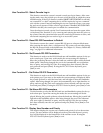General Information
EN | 63
caded Allegiant satellite system configuration. (see Section Appendix A “Satellite
Systems,” on page 78 for more information on satellite system configurations.)
Detailed descriptions of these options are listed below.
After entering the mode, move the joystick up or down to select the desired option.
Enter a valid user password, and press [Enter].
• CACHE REM CAM option (default factory setting). In this mode, satellite com-
mands are issued repetitively, regardless of whether the satellite camera is still
being viewed by an operator. This mode of operation is more desirable in stan-
dard systems because it minimizes delays when previous satellite cameras are
reselected. It is not recommended for use in cascaded systems. In cascaded sys-
tems, this mode could result in all available trunk lines coming from the 3rd
level satellite system to become used up, making them unavailable to the opera-
tors at the intermediate system.
• NO REM CAM CACHE option. In this mode, after the top level operator selects
a locally connected camera, the trunk line between the top level and the inter-
mediate level system will immediately be reset to its start-up camera (as defined
in the Monitor Table of the LTC 8059/00 MCS). This in turn frees up the trunk
line between the intermediate level system and the 3rd level system so it will be
available if needed by an operator at the intermediate level system.
In addition, this option changes the behavior of how the system determines
which trunk line to use. When this option is not used, a new trunk line (if avail-
able) will be used for each camera selection. When this option is enabled, an
operator's monitor will use the same trunk from the same bay as different cam-
eras are selected, as long as no other operator is viewing the same satellite cam-
era. In 3-tier cascaded satellite systems, this feature minimizes the use of trunk
lines by the top level Master system. This is especially advantageous when the
operator at the Master site is viewing cameras from the 3rd level satellite. Since
this will result in less trunk lines being used up, the intermediate Master/Satel-
lite system will have more access to trunk lines from the 3rd level satellite.
• SAT nnn PRIORITY option. If the top level master system and intermediate level
system in a cascade configuration can or will be set to operate as “Dual Master”
systems, a priority based satellite camera selection feature can be configured. In
a default cascaded satellite system configuration, satellite switching commands
are not associated with a user priority level. When a switching command sent
from a master site is received by a satellite, the switch selection can immediately
be overridden by operators at the satellite location having any priority level.
This situation is more likely to be encountered in 3-tier satellite systems that do
not have a good distribution of trunk lines (i.e., more between the top level sys-
tem and the intermediate level system than there are between the intermediate
system and the 3rd tier satellite).
Since dual master configurations support bi-directional communications, select-
ing the SAT nnn PRIORITY option for both the top level and intermediate level
master systems will result in the generation of priority based satellite com-
mands.
The satellite number assigned to the system that is currently being programmed
must be specified for the nnn value. This feature will enable use of the operator's
user priority to determine if access to a desired satellite camera is provided or
not. For instance, if no trunk lines are available and an operator requesting a sat-
ellite camera has higher priority than at least 1 of the existing operators, the
requested camera will be switched. If the operator does not have sufficient pri-


















